Brooks (Base) Square (BS) 101
~ The Architecture of Space-Time (TAOST)
&
The Conspicuous Absence of Primes (TCAOP) ~
I. TAOST / C. Geometrics – relationships / 2. Parallelogram
Table of Contents
I. TAOST - the network
A. Geometrics – lines
B. Geometrics - shapes
C. Geometrics - relationships
1. Pythagorean
2. Parallelogram <---
3. Penta
II. TCAOP - everything minus the network
I C. Geometrics - Relationships - 2.Parallelograms
Part 2- Parallelograms
Much of the work on parallelograms essentially laid down the early pathways to the magic kingdom of the “Penta,” that we will be looking at in great detail in the next section. “Parallelogram” started out by looking at the sums of the differences between the columns.
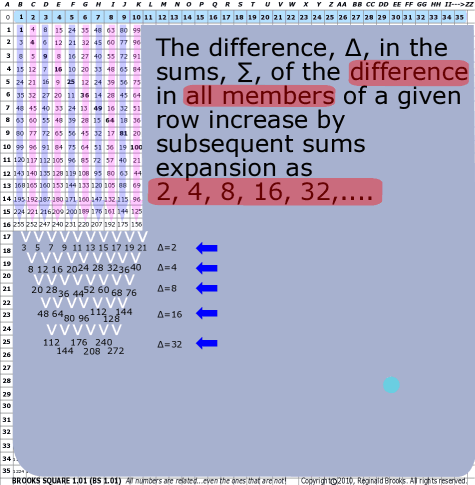
|
| ~click to enlarge image
|
| 100 |
BS Rule 100: The difference, ∆, in the sums, ∑, of the difference in all members of a given row increase by subsequent sums expansion as 2, 4, 8, 16, 32,....
|
Note:
|
∆
in
Row
Differnces
|
∆
sequentially across rows # values
in Columns B, C, D, ...
|
|
2
4
8
16
32
|
3 5 7 9 11 13 15 17 19 21 23 25
|
|
∑ of those ∆
sequentially across rows # values
in Columns B, C, D, ...
|
|
8 12 16 20 24 28 32 36 40 44 48
|
|
∑ of those ∆
sequentially across rows # values
in Columns B, C, D, ...
|
|
20 28 36 44 52 60 68 76 84 92
|
|
∑ of those ∆
sequentially across rows # values
in Columns B, C, D, ...
|
|
48 64 80 96 112
|
|
∑ of those ∆
sequentially across rows # values
in Columns B, C, D, ...
|
|
112 144 176 208
|
|
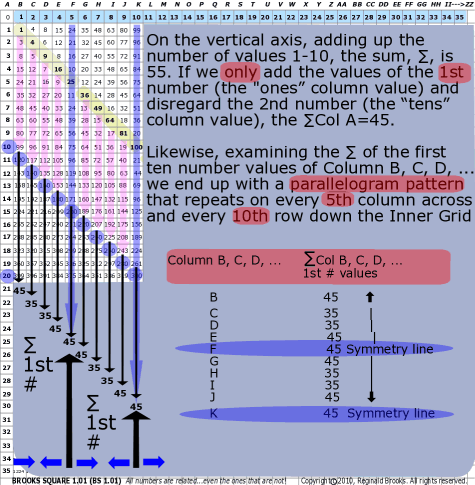
|
| ~click to enlarge image
|
| 101 |
BS Rule 101: On the vertical axis, adding up the number of values 1-10, the sum, ∑, is 55. If we only add the values of the 1st number (the ‘ones” column value) and disregard the 2nd number (the “tens” column value), the ∑Col A=45. Likewise, examining the ∑ of the first ten number values of Column B, C, D, ... we end up with a parallelogram pattern that repeats on every 5th column across and every 10th row down the Inner Grid.
|
Note:
|
Column B, C, D, ...
|
∑Col B, C, D, ... 1st # values
|
|
|
B
|
45
|
⬆
|
|
|
|
|
|
|
C
|
35
|
|
D
|
35
|
|
E
|
45
|
|
F
|
45
|
Symmetry line
|
|
G
|
45
|
|
|
|
|
|
⬇
|
|
H
|
35
|
|
I
|
35
|
|
J
|
45
|
|
K
|
45
|
Symmetry line
|
|
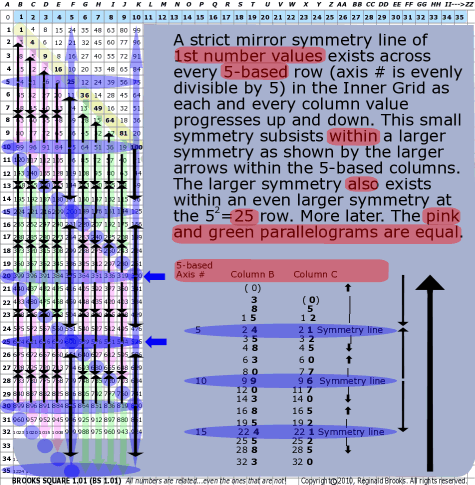
|
| ~click to enlarge image
|
| 102 |
BS Rule 102: A strict mirror symmetry line of 1st number values exists across every 5-based row (axis # is evenly divisible by 5) in the Inner Grid as each and every column value progresses up and down.
|
Note:
|
5-based
Axis #
|
Column B
|
Column C
|
|
|
|
( 0)
|
-
|
⬆
|
|
|
|
|
|
|
|
3
|
( 0)
|
|
|
8
|
5
|
|
|
1 5
|
1 2
|
|
5
|
2 4
|
2 1
|
Symmetry line
|
|
|
3 5
|
3 2
|
|
|
⬇
⬆
|
|
|
|
|
4 8
|
4 5
|
|
|
6 3
|
6 0
|
|
|
8 0
|
7 7
|
|
10
|
9 9
|
9 6
|
Symmetry line
|
|
|
12 0
|
11 7
|
|
|
⬇
⬆
|
|
|
|
|
14 3
|
14 0
|
|
|
16 8
|
16 5
|
|
|
19 5
|
19 2
|
|
15
|
22 4
|
22 1
|
|
|
|
25 5
|
25 2
|
|
|
⬇
⬆
|
|
|
|
28 8
|
28 5
|
|
|
32 3
|
32 0
|
|
[ TOP ]
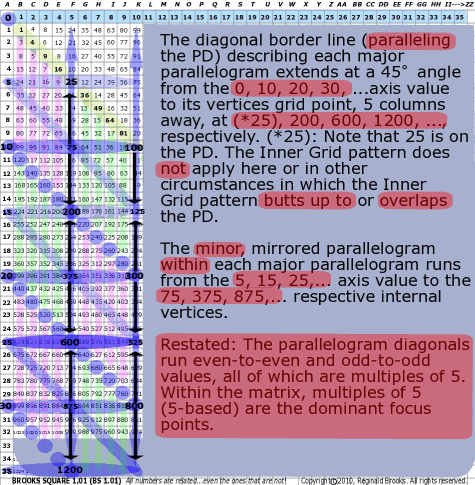
|
| ~click to enlarge image
|
| 103 |
BS Rule 103: The diagonal border line (paralleling the PD) describing each major parallelogram extends at a 45〫angle from the 0, 10, 20, 30, ...axis value to its vertices grid point, 5 columns away, at (*25), 200, 600, 1200, ..., respectively. (*25): Note that 25 is on the PD. The Inner Grid pattern does not apply here or in other circumstances in which the Inner Grid pattern butts up to or overlaps the PD.
|
Note: The minor, mirrored parallelogram within each major parallelogram runs from the 5, 15, 25,... axis value to the 75, 375, 875,... respective internal vertices. Restated: The parallelogram diagonals run even-to-even and odd-to-odd values, all of which are multiples of 5. Within the matrix, multiples of 5 (5-based) are the dominant focus points.
|
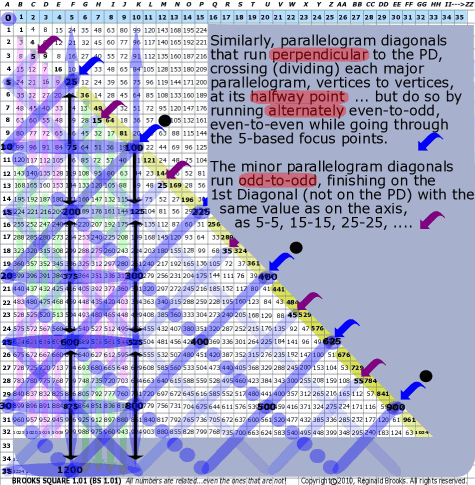
|
| ~click to enlarge image
|
| 104 |
BS Rule 104: Similarly, parallelogram diagonals that run perpendicular to the PD, crossing (dividing) each major parallelogram, vertices to vertices, at its halfway point ... but do so by running alternately even-to-odd, even-to-even while going through the 5-based focus points. The minor parallelogram diagonals run odd-to-odd, finishing on the 1st Diagonal (not on the PD) with the same value as on the axis, as 5-5, 15-15, 25-25, ....
|
Note: This pattern focuses on multiples of 5. Difference, ∆, steps.
|
[ TOP ]
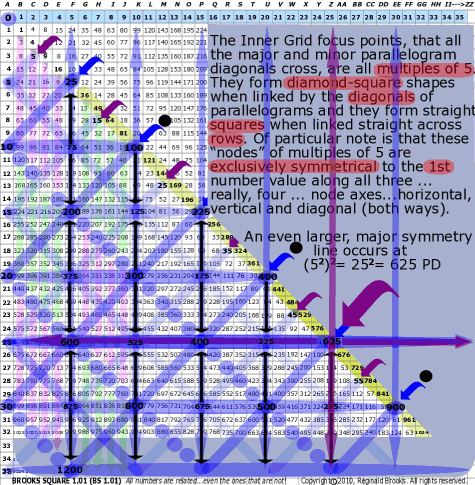
|
| ~click to enlarge image
|
| 105 |
BS Rule 105: The Inner Grid focus points, that all the major and minor parallelogram diagonals cross, are all multiples of 5 . These focus point are the subject of the next section (see “Penta”). They form diamond-square shapes when linked by the diagonals of parallelograms and they form straight squares when linked straight across rows. Of particular note here ... and of great interest in the “Penta” section ... is that these “nodes” of multiples of 5 are exclusively symmetrical to the 1st number value along all three ... really, four ... node axes ... horizontal, vertical and diagonal (both ways). An even larger, major symmetry line occurs at (52)2 = 252 = 625 PD.
|
|
|
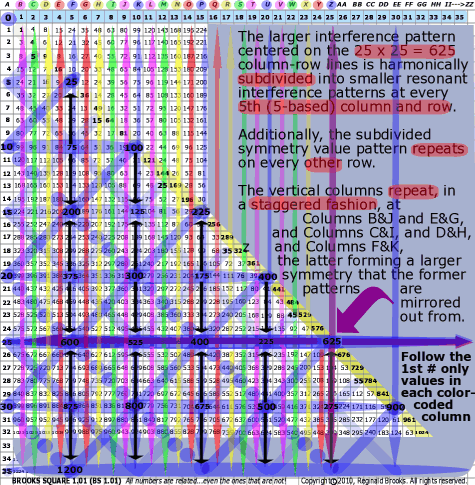
|
| ~click to enlarge image
|
| 106 |
BS Rule 106: The larger column symmetry of the 1st (“ones”)
number values, while symmetrical at the 25-625 row and column lines, additionally, repeats symmetrically outward from each 5-based column.
|
Note: Restated: The larger interference pattern centered on the 25 x 25 = 625 column-row lines is harmonically subdivided into smaller resonant interference patterns at every 5th (5-based) column and row. Additionally, the subdivided symmetry value pattern repeats on every other row. The vertical columns repeat, in a staggered fashion, at Columns B&J and E&G, and Columns C&I, and D&H, and Columns F&K, the latter forming a larger yet symmetry that the former are mirrored out from.
|
⬅------------
|
Symmetry
line
|
--------➜⬅----------
|
Symmetry
line
|
|
B
|
|
|
|
|
|
|
|
J
|
|
|
|
|
|
E
|
|
G
|
|
|
|
|
|
|
C
|
|
|
|
|
|
I
|
|
|
|
|
|
D
|
|
|
|
H
|
|
|
|
|
|
|
|
|
F
|
|
|
|
|
K
|
|
[ TOP ]
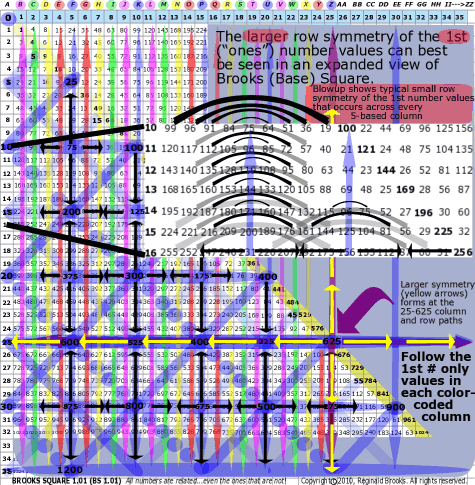
|
| ~click to enlarge image
|
| 107 |
BS Rule 107: The larger row symmetry of the 1st (“ones”) number values can best be seen in an expanded view of Brooks (Base) Square.
|
Note:
|
|
⬅------------
|
Symmetry
line
|
--------➜⬅----------
|
Symmetry
line
|
|
0
|
5 10 15 20
|
25
|
30 35 40 45
|
50
|
|
5
|
25
|
|
|
|
⬆
|
|
|
|
|
|
|
|
|
|
|
|
10
|
|
100
|
|
|
|
|
|
|
|
|
15
|
|
|
225
|
|
|
|
|
|
|
|
20
|
⬆
|
⬆
|
⬆
|
400
|
|
|
|
|
|
|
25
|
600
⬅
|
525
⬅
|
400
⬅
|
225
⬅
|
625
|
➜
|
➜
|
➜
|
➜
|
|
|
30
|
⬇
|
⬇
|
⬇
|
500
|
|
|
⬇
⬆
|
|
900
|
|
|
|
|
|
35
|
|
|
1000
|
|
|
1225
|
|
|
|
|
40
|
|
1500
|
|
|
|
|
1600
|
|
|
|
45
|
2000
|
|
|
|
|
|
|
2025
|
|
|
50
|
|
|
|
|
|
|
|
|
|
2500
|
|
[ TOP ]
NEXT: On to
I. TAOST>IC. Geometrics-relationships>IC3. Penta - Brooks (Base) Square
Back to I. TAOST>IC. Geometrics-relationships>IC1. Pythagorean - Brooks (Base) Square
Page 2a-
PIN: Pattern in Number...from primes to DNA.
Page 2b-
PIN: Butterfly Primes...let the beauty seep in..
Page 2c-
PIN: Butterfly Prime Directive...metamorphosis.
Page 2d-
PIN: Butterfly Prime Determinant Number Array (DNA) ~conspicuous abstinence~.
Page 3-
GoDNA: the Geometry of DNA (axial view) revealed.
Page 4-
SCoDNA: the Structure and Chemistry of DNA (axial view).
Page 5a-
Dark-Dark-Light: Dark Matter = Dark
Energy
Page 5b-
The History of the Universe in Scalar
Graphics
Page 5c-
The History of the Universe_update: The Big
Void
Page
6a- Geometry-
Layout
Page
6b- Geometry- Space Or Time Area
(SOTA)
Page 6c- Geometry-
Space-Time Interactional
Dimensions(STID)
Page
6d- Distillation of SI units into ST
dimensions
Page
6e- Distillation of SI quantities into ST
dimensions
Page
7- The LUFE Matrix Supplement: Examples and Proofs: Introduction-Layout &
Rules
Page 7c-
The LUFE Matrix Supplement:
References
Page
8a- The LUFE Matrix: Infinite
Dimensions
Page 9-
The LUFE
Matrix:E=mc2
Page 10-
Quantum Gravity ...by the
book
Page
11- Conservation of
SpaceTime
Page
12- LUFE: The Layman's Unified Field Expose`
Page
13- GoMAS: The Geometry of Music, Art and Structure ...linking science, art and esthetics. Part I
Page
14- GoMAS: The Geometry of Music, Art and Structure ...linking science, art and esthetics. Part II
Page
15- Brooks (Base) Square (BS): The Architecture of Space-Time (TAOST) and The Conspicuous Absence of Primes (TCAOP) - a brief introduction to the series
Page
16- Brooks (Base) Square interactive (BBSi) matrix: Part I "BASICS"- a step by step, multi-media interactive
Page
17- The Architecture Of SpaceTime (TAOST) as defined by the Brooks (Base) Square matrix and the Inverse Square Law (ISL).
Copyright©2009-12 Reginald Brooks, BROOKS DESIGN. All Rights
Reserved.
(function() {
var toJsLink = function(link) {
// Check the escape conditions
if (link.href === undefined) { return; }
if (link.onclick) { return; }
if (link.className.indexOf('bkry-link-ignore') !== -1) { return; }
var handler = function(evt) {
// Look out for escape conditions
if (link.href.indexOf('#')) {
var targetUrl = link.href.split('#')[0];
var currentUrl = window.location.href.split('#')[0];
if (targetUrl === currentUrl) {
return;
}
}
// Salt in the query string argument to make sure it always gets passed around
var url = link.href;
var hash = url.split('#')[1];
url = url.split('#')[0];
var qs = url.split('?')[1];
url = url.split('?')[0];
evt.preventDefault();
window.location = url + '?' + (qs || '') + (qs ? '&' : '') + 'bkry-rewrite-links=true' + (hash ? '#' + hash : '')
return false;
};
// Bind the event handler down
if(link.addEventListener) {
link.addEventListener('click', handler, false)
} else if(link.attachEvent) { // old ie support
link.attachEvent('onclick', handler)
}
};
if (window.location.search.indexOf('bkry-rewrite-links=true') !== -1) {
// Look for new nodes
window.addEventListener('DOMNodeInserted', function(e) {
if (e.target.tagName = 'A') { toJsLink(e.target); }
}, false);
// Look for existing nodes
var links = document.getElementsByTagName('a');
for (var i = 0; i < links.length; i++) {
toJsLink(links[i]);
}
}
})();







